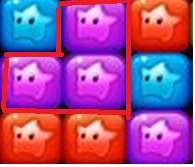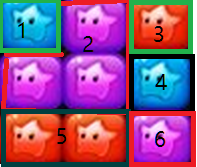- 问题需求讲解
其实第一次写简单的消消乐的代码,是在N多年前入职后的一次新员工的编码比赛上,因为当时允许C++,让我不得不重新翻了几遍丢到角落好多年的《谭浩强C++》。消消乐的需求非常直观明了,每个消消乐的游戏规则或许都有差异,但是不变的是,都是对相同类型的栅格先进行聚合,再判定是否需要进行消除。假设有如下9宫格:

那么首先就需要找出红线区域内的聚合区域。因为我们专题是染色算法,所以重点讲解如何通过染色算法求得聚合区域。
问题简述为:
在nxm的图内,求所有同类型的栅格的聚合区域。
输入:int[]
每个栅格int值表示不同类型。
输出:List<List<int>>
每个int值表示索引号
- 算法讲解
要求得聚合区域,其实就是找寻一个栅格周围4格子是否和其一个类型,如果一个类型,那么再找这个栅格的周围4个格子,直到
1,当前栅格是已经遍历过的
2,当前格子不是同样类型的
从第一个栅格开始,按这种逻辑进行聚合。再看第二个栅格是否是已遍历过的,如果不是,那么继续按第二个栅格进行聚合,直到所有栅格都遍历过。那么就可以得到一个各个区域都聚合完毕的集合。如下图:

算法流程图如下:

- 代码展示
public static List<List<int>> GatherGrids(int[] map,int height,int width)
{
var l = map.Length;
var color = new bool[l];
var result=new List<List<int>>();
for (int i = 0; i < height; i++)
{
for (int j = 0; j < width; j++)
{
if (color[i*width + j])
{
continue;
}
var region = new List<int>();
Stack<int> stack=new Stack<int>();
stack.Push(i*width + j);
while (stack.Count>0)
{
var index = stack.Pop();
if (color[index])
{
continue;
}
region.Add(index);
color[index] = true;
var style = map[index];
if (index% width != 0)
{
GatherNextStep(map, index - 1, l, color, style, stack);
}
if (index% width != width - 1)
{
GatherNextStep(map, index + 1, l, color, style, stack);
}
GatherNextStep(map, index-width, l, color, style, stack);
GatherNextStep(map, index+width, l, color, style, stack);
}
result.Add(region);
}
}
return result;
}
没有采用X,Y二维的建模,导致需要做出额外的边界判断,来确保下一步获取的4个方向的Index是正确的。
每次Pop获取当前Index,会首先判断是否已经染过色的索引,防止两个邻居的邻居是同一个栅格,会重复添加。
当然也可以在添加时,判断下栈里是否已经添加。
private static void GatherNextStep(int[] map, int nextIndex, int l, bool[] color, int style, Stack<int> stack) { if (IsIndexValid(nextIndex, l) && !color[nextIndex] && map[nextIndex] == style) { stack.Push(nextIndex); } }
private static bool IsIndexValid(int index, int l) { return index >= 0 && index < l; }
越界合理性判断。
代码已放入GitHub欢迎pull,欢迎指出bug。
https://github.com/suriyel/EliminateGame/